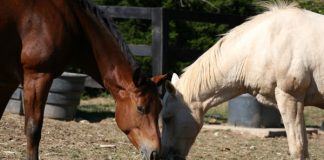 |
| Using weight tape at the heart girth may not measure small changes in weight. Photo: Leslie Potter |
The problem of equine obesity has been at the top of horse health headlines recently as more owners learn about the serious health risks associated with overweight horses. One of the difficulties in keeping horses at a healthy weight is finding an accurate measurement.
Two recent studies at the University of Liverpool have shown that a weight tape can still be a useful tool in monitoring weight change. Researchers suggest that taking a measurement at the widest point of the belly, approximately two thirds of the way from the point of shoulder to the point of hip, gives a more accurate measurement than a heart girth measurement. Horses store excess fat around their belly, not at the heart girth, so smaller changes in weight do not always affect the heart girth measurement.
One of the Liverpool studies also showed that the widely used equine body condition scoring system may not be an adequate tool for monitoring weight loss in obese equines. This research studied overweight and obese ponies. During the research, the ponies lost weight according to ultrasound, heart girth and belly girth measurements. However, their body condition scores did not change.
For owners working to bring their overweight or obese equines to a healthy weight, the research suggests that using belly girth measurements may be the best practical way to monitor early weight loss.
Managed weight loss in obese ponies: evaluating weight change, health and welfare, A Dugdale, G Curtis, C McG Argo, (Department of Clinical Science, University of Liverpool, UK), PA Harris (Equine Studies Group WALTHAM Centre for Pet Nutrition, UK).
CG Curtis, AHA Dugdale, D Grove-White and C.McG Argo. (University of Liverpool, UK) PA Harris. (Equine Studies Group WALTHAM Centre for Pet Nutrition, UK) CF Barfoot. (Mars Horsecare UK Ltd)






Maybe someday we’ll have an even easier way to weigh horses.
Will have to use this trick on my tubby pony and minis.
Cool!
One thing that never makes sense to me is that diets are based on the weight of the horse but if the horse is already obese then one will be feeding the horse based on it being heavier than it should.
I AGREE 100%! They suggest what you should feed a horse that weighs _____lbs, but they don’t tell you how much the ration should be for the horse to LOSE weight! Patti